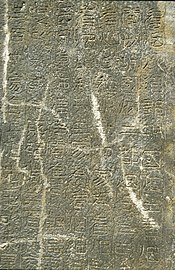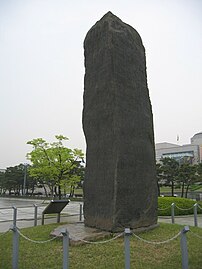Gwanggaeto stele
The Gwanggaeto stele is a memorial stone to Gwanggaeto (374–413 AD), who was king of Goguryeo from 391 until his death . The stele is located in China near the border with North Korea . The inscription carved into the stele is the oldest and most detailed surviving source on the history of the Kingdom of Goguryeo .
location
The stele stands about 5 kilometers northeast of the city center of the city of Ji'an , which belongs to the administrative area of the prefecture-level city of Tonghua and lies in the south of the Jilin province of the People's Republic of China on the Yalu River , which forms the border with North Korea . It stands about 200 meters northeast of the tomb of King Gwanggaeto , of whom it commemorates.
history
Under King Gwanggaeto (ruled 391-413) and his son Jangsu (ruled 413-490), the kingdom of Goguryeo , one of the so-called three kingdoms of Korea , reached its greatest extent. At the time of Gwanggaeto, Guonei Cheng and Wandu Shancheng , both in the area of what is now Ji'an , were capital cities of the empire. After Gwanggaeto's death in 414, Jangsu erected the inscribed stele near his father's tomb.
When the kingdom of Goguryeo and his successor Balhae (926) fell in 668 , the region around Guonei and Wandu lost its importance. After the Chinese Empire was conquered by the Manchu in 1644, the emperors of the new Qing dynasty declared a wide area north of the Yalu River a restricted area. The area was only released for settlement again in the second half of the 19th century. Around 1876 a Chinese official rediscovered the completely overgrown stele, which was partly sunk into the ground.
In 1883 a Japanese officer who was incognito in Korea made a copy of the inscription and brought it to Japan. Japanese sinologists examined the text and published their results in 1889. The first copies of the stone surface were made in 1887 and examined by Chinese scientists. The first results were published in 1895. In Korea, the existence of the stele was not found out until 1889 through the Japanese publication.
Replicas of the stele have been set up in Korea, including in Seoul and in the Independence Hall of Korea in Cheonan .
In 2004, the Gwanggaeto stele was included in the UNESCO World Heritage list as part of the World Heritage Site capitals and tombs of the ancient Kingdom of Koguryo . It was emphasized that "the stele and a long inscription in one of the tombs show the influence of Chinese culture on Koguryo, which did not develop its own script."
description
The stele is formed from a monolithic block about 7 meters high. It has an approximately square cross-section and a circumference of about 4 meters. On all four sides it is almost completely provided with incised Chinese characters in classical Chinese , a total of around 1800. The stele is surrounded by a pavilion to protect it.
inscription
The text of the inscription can be divided into three different parts. The first part describes the legend of the founding of Goguryeo by the legendary King Dongmyeong (Chumo), who came from Buyeo , moved from there and founded his own kingdom. After this kingdom flourished for a while, he was caught up in the sky by a golden dragon, and his son Yuri became king. A line is drawn from him to King Gwanggaeto . The second part describes the deeds of Gwanggaeto, especially his campaigns. Subdivided into years, various campaigns of conquest and punitive expeditions against insurgents and their successes are listed. It was very often against Baekje . The third part relates to grave maintenance and lists gravekeeper families.
An unclear and partly illegible passage in the second part, according to which the “Wa” came across the sea in AD 391 and subjugated Baekje and Silla, led to a still unresolved dispute between Korean and Japanese scientists . Apart from the fact that it remains open whether the Wa actually meant the Japanese, it is also unclear whether the Wa or Gwanggaeto itself should have subjected Baekje and Silla.
photos
literature
- Daniel C. Kane: Enigma in Stone . In: Archaeological Institute of America (Ed.): Archeology . tape 55 , no. 2 (March / April 2002), ISSN 0003-8113 , p. 60-66 , JSTOR : 41779666 .
Web links
Individual evidence
- ↑ State Administration of Cultural Heritage of the People's Republic of China (ed.): Capital Cities, Imperial Tombs, and Nobles Tombs of Koguryo . Nomination as a World Heritage Site. 2003 ( unesco.org [PDF; 7.0 MB ]).
- ↑ Kane 2002, p. 61.
- ↑ Capital Cities and Tombs of the Ancient Koguryo Kingdom. In: whc.unesco.org. UNESCO World Heritage Center, accessed June 8, 2018 .
- ↑ Kane 2002, p. 64.
Coordinates: 41 ° 8 ′ 41.6 ″ N , 126 ° 12 ′ 51.2 ″ E






